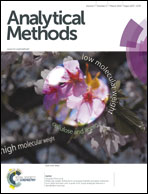Molecularly imprinted electrochemical sensor for selective determination of oxidized glutathione
Abstract
By using oxidized glutathione as a template molecule and o-phenylenediamine as a functional monomer, a molecularly imprinted polymer film was prepared on the surface of a glassy carbon electrode via electro-polymerization. The recognition performance of the molecularly imprinted membrane was characterized by cyclic voltammetry and electrochemical impedance spectroscopy. The detection of oxidized glutathione was conducted by differential pulse voltammetry based on the electrochemical reaction of potassium ferricyanide/potassium ferrocyanide on the electrode passing through the cavities of the molecularly imprinted membrane after the template molecules were eluted. The results showed that a linear relationship between oxidation currents and oxidized glutathione concentrations in the range of 0–8 × 10−7 mol L−1 was observed with a detection limit of 1.8 × 10−9 mol L−1 given a signal-to-noise ratio of 3 : 1. The sensor was applied to the assay of human plasma with satisfactory results.


 Please wait while we load your content...
Please wait while we load your content...